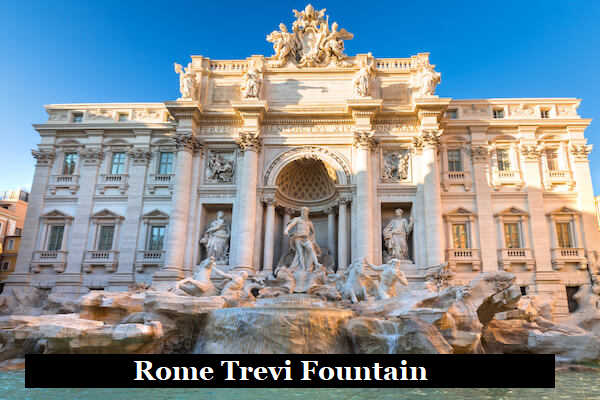Rome Trevi Fountain – The Most Beautiful Fountain In Rome

The Rome Trevi Fountain: A Roman Masterpiece
Introduction: The Trevi Fountain, or “Fontana di Trevi” in Italian, is not just a fountain. It is a monumental tribute to the grandeur of Roman baroque art and a testament to Rome’s long-standing love affair with water. Located in the Quirinale district of Rome, this iconic landmark is often crowded with tourists tossing coins and making wishes.
Also Read:- 10 Best PlacesTo Visit in Rome
Historical Background: The history of the Trevi Fountain dates back to ancient Rome. Its origins are tied to the Roman custom of building a handsome end monument to mark the terminus of an aqueduct. The Aqua Virgo, an aqueduct constructed in 19 BC by Agrippa, the son-in-law of Emperor Augustus, brought water to the baths of Agrippa and supplied the city of Rome with fresh water. The name “Virgo” (Virgin) is believed to be named after a young Roman girl who pointed out the spring source to Roman soldiers.
Renaissance Revival: For many centuries, the Aqua Virgo served Rome without interruption, but over time, the endpoint became less grand. In the Renaissance period, popes sought to revive the glory of Rome by commissioning grand architectural projects. It was Pope Nicholas V who began restoring the city’s main aqueducts in the late 15th century.
Baroque Grandeur: The Trevi Fountain, as we see it today, was envisioned during the Baroque period. Pope Clement XII organized a design competition in 1730, which was won by architect Nicola Salvi. Construction began in 1732 and, despite several complications and changes in leadership, was completed in 1762, long after Salvi’s death in 1751. Giuseppe Pannini, another architect, saw the project through its final stages.
Design and Symbolism: The fountain is an intricate blend of sculpture and architecture. The central figure is Oceanus, the sea god, standing beneath a triumphal arch. On either side of Oceanus are statues representing Abundance and Salubrity. Above the arch, the Papal Coat of Arms is held aloft by angels. The fountain is set against the backdrop of Palazzo Poli, giving the illusion that the palace is an integral part of the fountain’s design.
Water cascades over rocks and is collected in a large basin, which is always full of coins. According to legend, if you throw a coin over your left shoulder using your right hand, you will ensure a return to Rome. This tradition is inspired by the ancient Romans, who often threw coins in fountains to please the water gods and ensure their safe journey back home.
Conclusion: The Trevi Fountain is more than just a visual marvel; it is a symbol of Rome’s rich history, from its ancient aqueducts to its Baroque artistry. Its blend of mythology, art, and architecture encapsulates the very essence of Rome. Whether viewed during the day, with sunlight shimmering across its waters, or at night, illuminated in all its glory, the Trevi Fountain remains an eternal tribute to the Eternal City.










